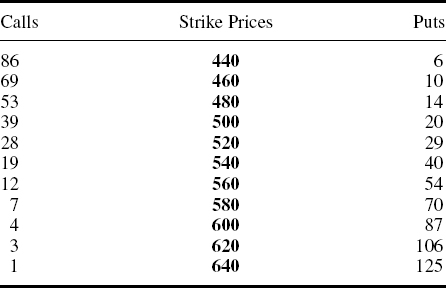14
Long Put Spreads (Bear Put Spreads)
What is a put spread? A put spread consists of two legs, a long put and a short put. A long put spread, sometimes called a bear put spread (because it is bearish in nature) consists of a long put with a higher strike and a short put with a lower strike.
For example, from the matrix of Sep BP option prices (Table 14.1), repeated from (Table 12.5), buying the 500/460 put spread consists of two legs, buying the 500 put at 20 and simultaneously selling the 460 put at 10. The cost of the put spread is 10 ticks (equivalent to £100 per spread), the difference between the 20 ticks paid for the 500 put and the 10 ticks received from the sale of the 460 put. These 10 ticks represent the maximum loss on buying the put spread. If BP is at or above 500 (i.e. £5.00) on Sep expiry, then both the 500 and 460 puts will expire worthless. The maximum possible value of the put spread is 40, the difference between the two strike prices of 500 and 460. If BP is at or below 460 (i.e. £4.60) on Sep expiry, then the 500 put will be worth exactly 40 more than the 460 put.
Table 14.1 LIFFE September BP option prices (BP share price (LSE) = 522 (i.e. £5.22), LIFFE BP September future = 519 (i.e. £5.19))

For example, if BP is priced at exactly 460 (i.e. £4.60) on Sep expiry, then the 500 put will be worth exactly 40 and the 460 put will be worthless. The difference between ...
Get Equity and Index Options Explained now with the O’Reilly learning platform.
O’Reilly members experience books, live events, courses curated by job role, and more from O’Reilly and nearly 200 top publishers.

